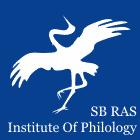 |
|
||||||||||||
|
Institute of Philology of
the Siberian Branch of Russian Academy of Sciences |
|
||||||||||||
|
|||||||||||||
DOI: 10.25205/2410-7883 Roskomnadzor certificate number Эл № ФС 77-84792 | |
| Syuzhetologiya i Syuzhetografiya | |
|
Article
Authors: Konstantin A. Sagalaev Institute of Philology of the Siberian Branch of the Russian Academy of Sciences, Novosibirsk, Russian Federation In the section Plot, motif, genre in literature and folklore
Abstract: The article discusses a plot common to the folklore of Siberian peoples: a child is kidnapped and replaced by a changeling, a creature hostile to humans. When the boy grows up, he learns the truth, takes revenge on the deceiver, and returns to his real mother. The article examines Ket tales about a woman and a chthonic creature named Kolbasam. A concise overview of the Kets’ geographical distribution and language is given. Nine texts with this plot, recorded between the early 20th and early 21st centuries, are analyzed. Some of the texts were recorded during a folklore and ethnographic expedition in which the author participated and have not been published before. The plot of all the texts is briefly retold, and twelve main components of their motifs are identified (such as deception while bathing, child swapping, violation of a prohibition, unmasking a devil by the number of fingers, using a ruse by the hero to burn down the antagonist, the appearance of mosquitoes from the ashes of the burned creature, the hero's revenge by pouring soup into enemy’s boots, the hero’s transformation into animals and birds, etc.). Their correspondences in Yu. E. Berezkin and E. N. Duvakin’s “Thematic Classification and Distribution of Folklore and Mythological Motifs by Area” are also indicated. Ethnographic comments are provided to explain words related to the traditional lifestyle of Ket people that may be unfamiliar to the reader. The frequency of use of each motif in each text is analyzed; on this basis, the most complete versions of the plot are identified. The conclusion is made about the gradual reduction in the number of motifs in this plot and the possible loss of some of the original meanings (for example, the association of the lower side of a lake with danger and evil forces). At the same time, tracing the development of this type of plot up to the beginning of the 21st century allows us to conclude that it is still preserved and alive. The article is intended for folklorists, literary scholars, and specialists in traditional Ket culture. Keywords: plot, motif, child substitution, Ket folklore, fairy tale, degree of preservation Bibliography: Alekseenko E. A. Kety [The Kets]. In: Mify i religii mira [Myths and religions of the world]. Moscow, 2004, pp. 256–261. (in Russ.) Alekseenko E. A. Mify, predaniya, skazki ketov [Myths, legends, and tales of the Kets]. Moscow, 2001, 343 p. (in Russ.) Berezkin Yu. E., Duvakin E. N. Tematicheskaya klassifikatsiya i raspredelenie fol'klorno-mifologicheskikh motivov po arealam [Thematic classification and distribution of folklore and mythological motifs by region]. (in Russ.) URL: https://ruthenia.ru/folklore/berezkin/ (accessed 13.09.2025). Butorin S. S. Ketskii yazyk. Istoricheskaya entsiklopediya Sibiri [Historical Encyclopedia of Siberia]. Novosibirsk, 2009, vol. 2: K–R, pp. 63–64. (in Russ.) Dolgikh B. O. Kety [The Kets]. Irkutsk, 1934, 134 p. (in Russ.) Dulzon A. P. Ketskie skazki [Ket fairy tales]. Tomsk, 1966, 162 p. (in Russ.) Dulzon A. P. Skazki narodov Sibirskogo Severa [Fairy tales of the peoples of the north of Siberia]. Tomsk, 1972, vol. 1, 201 p. (in Russ.) Ivanov V. N., Toporov V. I. Kommentarii k opisaniyu ketskoi mifologii [Commentary on the description of Ket mythology]. In: Ketskii sbornik. Mifologiya, etnografiya, teksty [Ket Collection. Mythology, ethnography, texts]. Moscow, 1969, pp. 148–167. (in Russ.) Kozlova N. K. Chto est' motiv (eshche raz k voprosu o nauchnoi terminologii) [What is the motive (back to the question of scientific terminology)?]. Yazyki i fol'klor narodov Sibiri [Languages and Folklore of Indigenous Peoples of Siberia], 2018, no. 2 (36), pp. 82–87. (in Russ.) Nikolaeva G. Kh. Ketskie narodnye skazki [Fairy tales of the Ket people]. Krasnoyarsk, 2006, 209 p. (in Russ.) Osharov M. I. Severnye skazki. Sobrany i obrabotany M. Osharovym [Northern Tales. Collected and edited by M. Osharov]. Novosibirsk, 1936, 269 p. (in Russ.) |
 |
Institute of Philology Nikolaeva st., 8, Novosibirsk, 630090, Russian Federation +7-383-330-15-18, ifl@philology.nsc.ru |
© Institute of Philology |


